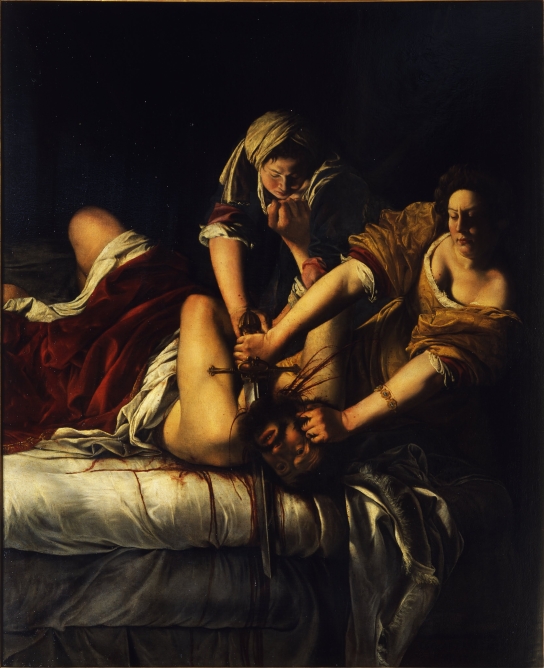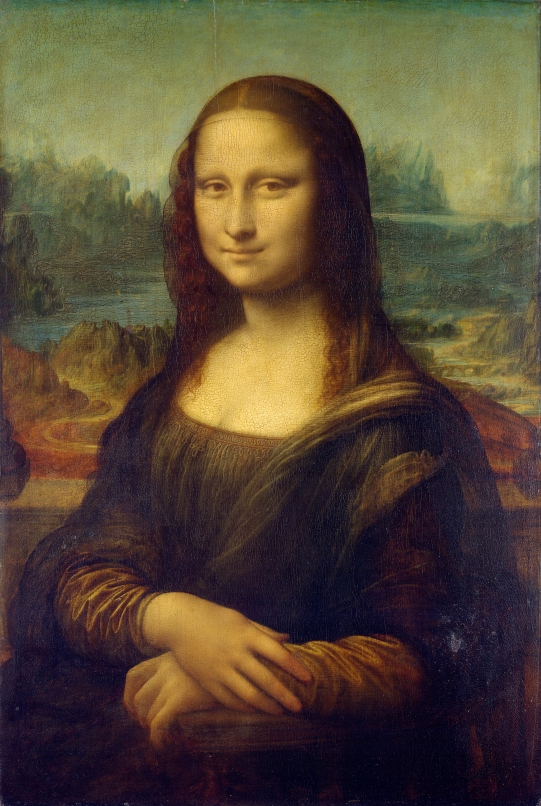Several influences changed how art was viewed in the Baroque age. Between 1545 and 1563, The Council of Trent convened in three sessions, in an effort to enact a Counter-Reformation. This church council that meant to define Roman Catholicism, the reach of which was felt intensely within the Arts. This shift from the church meant a move away from the secular narratives and more towards the sacred. The church also realized that the Arts could be used as a tool to educate and further guide believers. This inspired artists to find a new way to interest the viewing public. Enter such techniques as tenebrism, realism, using energy/movement, and involving the observer.
 Artemisia Gentileschi’s Judith Slaying Holofernes c. 1620 Florence, Italy
Artemisia Gentileschi’s Judith Slaying Holofernes c. 1620 Florence, Italy
Judith Slaying Holofernes portrays all of these elements. Painted by Artemisia Gentileschi, it shows an intense scene of Judith, a widow, in the process of beheading Holofernes, an Assyrian general. Her actions were enough to enable Israel to counter the Assyrian’s attack on her home.
While gruesome, even by today’s standards, this painting bears all of these elements. One matter I appreciate from this work is the intense energy, the implied force that it would take to sever a man’s head, without showing the swing itself. The brute strength used by Judith as she holds his head is undeniable. There is no doubt to the struggle that Holofernes is putting up in an effort to fight off his attackers.
After moving to Florence, Italy, Artemisia thrived as an artist, becoming known by The Grand Duke of Tuscany, Cosimo De’Medici, of whom this painting was commissioned for, and later, King Philip IV of Spain. She befriended artists, thinkers, and writers, even one certain astronomer, Galileo. It has been said, though not substantiated, that her friendship with Galileo was where she learned the proper spray pattern of the blood splatter on Judith, giving another layer of realism in an almost surreal topic.
Comparing the Differences
At first glance, some of these elements may not be as easy to notice without comparison.
 Leonardo Da Vinci’s Mona Lisa, c.1505 Florence, Italy.
Leonardo Da Vinci’s Mona Lisa, c.1505 Florence, Italy.
Compare Gentileschi to a Renaissance painting, one we are all familiar with, the Mona Lisa, by Leonardo Da Vinci. While the latter at first appears to be engaging the viewer with her eyes, actually upon closer inspection, her gaze is off to the side. She sits in complete stillness with a landscape in the background. All of these things are the opposite of Judith Slaying Holofernes, which displays action and the contrast of the dark background with the light on the subjects to focus the viewer’s attention. While to some, these may not sound like very astounding differences, those differences are what defines both the Renaissance period and the Baroque period.
Works Cited
Bio.com. A&E Networks Television. Web. 28 Sept. 2016. http://www.biography.com/people/artemisia-gentileschi-9308725#final-years
“Artemisia Gentileschi and the Authority of Art.” Google Books. Web. 28 Sept. 2016. https://books.google.com/books?id=JSM1su0WJ6EC&pg=PA216&lpg=PA216&dq=artemisia+gentileschi+galileo+galilei&source=bl&ots=U6qf83WK5h&sig=uV9_5J87p8v-dTTPYiUW4Fe-FVs&hl=en&sa=X&ei=fmfcUea3BPje4AP8rYCwCA&ved=0CFcQ6AEwBA#v=onepage&q=artemisia%20gentileschi%20galileo%20galilei&f=false
“Judith and Holofernes by Artemisia Gentileschi -.” Judith and Holofernes by Artemisia Gentileschi –. Web. 28 Sept. 2016. http://www.uffizi.org/artworks/judith-and-holofernes-by-artemisia-gentileschi/
By Combining This Theatrical Dynamism with Careful Observation from Life, Caravaggio Achieved a Gritty Naturalism in Both Genre and Religious Scenes. His Subdued Palette, Half-length Figures, and Magnification of the Picture-plane to Create Intimate, Rela, Dr. Esperança Camara. “Khan Academy.” Khan Academy. N.p., n.d. Web. 28 Sept. 2016. https://www.khanacademy.org/humanities/monarchy-enlightenment/baroque-art1/baroque-italy/a/gentileschi-judith-slaying-holofernes
“Mona Lisa.” Wikipedia. Wikimedia Foundation. Web. 28 Sept. 2016. https://en.wikipedia.org/wiki/Mona_Lisa
That first painting by Gentileschi is intense. I can see the force you described in the painting. An Assyrian general was undoubtedly a powerful man. It’s interesting to see him killed by two women, the historically marginalized gender. I think the painting you posted is great, but I’m having some difficulty seeing the relation to the Mona Lisa. The paintings seem too different to compare. I would be curious to see how you differentiated the Mona Lisa with the famous Baroque painting, Girl with a Pearl Earring by Vermeer.
http://www.essentialvermeer.com/catalogue/girl_with_a_pearl_earring.html#.V-8vpvArJhE
I think this portrait has many resemblances to the Mona Lisa, such as the dubious eye contact. However it has several notable differences, such as the background that you mentioned, as well as starkly different uses of light and shadow.
LikeLike
I agree with your analysis on the connection between the Council of Trent and the influence the council had on the arts, for example as you mentioned, inspiring them to find new techniques to keep the interest of the public. I can see the intense energy that you had described from the painting and the strength of Judith. I admire the amount of realism present in the painting, it is as if you are part of the scene depicted. I also found your comparison of Leonardo Da Vinci’s “Mona Lisa”, and “Judith Slaying Holofernes” by Artemisia Gentileschi’s unique and informative. Here is a link regarding information on the technique you had mentioned above about “tenebrism”, I found the information interesting. http://www.visual-arts-cork.com/painting/tenebrism.htm
LikeLike